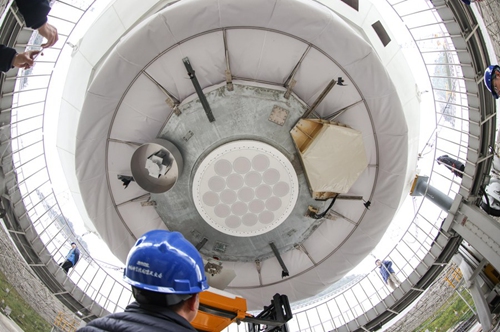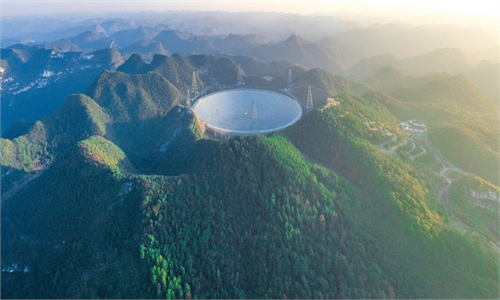Discovering 500 new, China's FAST telescope becomes world's most efficient facility for discovering pulsars

Staff members conduct maintenance work at China's Five-hundred-meter Aperture Spherical Radio Telescope (FAST) in southwest China's Guizhou Province, Dec. 17, 2021.(Photo: Xinhua)
Chinese scientists have identified over 500 new pulsars using the 500-meter Aperture Spherical radio Telescope (FAST), known as China's Tianyan or "Sky Eye," making it the most efficient facility for discovering pulsars in the world since its operation started on January 11, 2020.
FAST's annual observation time has exceeded 5,300 hours, beyond the expectation from international peers, the National Astronomical Observatories of the Chinese Academy of Sciences (CAS) told the Global Times on Thursday.
Using the FAST, an international team led by Li Di, a scientist from National Astronomical Observatories with the CAS, has obtained accurate magnetic field strength in molecular cloud, a region of the interstellar medium that seems ready to form stars.
The study was published in Nature as a cover story on Thursday, according to the CAS.
This was the latest scientific achievement Chinese researchers have made with the help of the FAST.
Richard Crutcher, an Emeritus Professor of astronomy at the University of Illinois, said that this discovery is crucial to understanding astrophysics of star formation and illustrates the importance of FAST to address important unsolved astrophysical problems, according to a press release from the CAS.
Crutcher said that he visited FAST a few years ago, and was impressed with the facility for being by far the largest and most powerful single-dish radio telescope in the world, giving FAST a potential for breakthroughs in science.
Wu Xiangping, an academician with the CAS, said on Wednesday that about 1 percent of the observation time of the FAST will be opened to Chinese primary and middle school students and they can propose scientific ideas and then scientists will help them to implement their ideas.
Located in a naturally deep and round karst depression in Southwest China's Guizhou Province, FAST started formal operation in January 2020.
Fast was officially opened to the world on March 31, 2021, and about 10 percent of FAST's observation time in the first year, roughly 450 hours, was expected to be allocated to foreign scientists.


